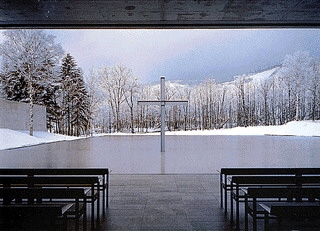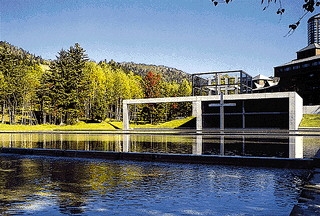
Church on the Water

“You cannot simply put something new into a place. You have to absorb what you see around you, what exists on the land, and then use that knowledge along with contemporary thinking to interpret what you see.” T.Ando
The Church on the Water is located in Tomamu, east of the city of Sapporo on the northern Japanese island of Hokkaido. It was designed by Tadao Ando between 1985 and 1988, and it was built in an astonishingly quick five months in 1988. The site is in a clearing in a beech forest, and slopes down towards a small river. Hills surround the site to the west, and a resort hotel lies behind the church, to the east.
The church faces a large pond, 80m by 42.7m in size. The pond steps down in five stages towards the small river. At the high end of the pond is the building, the shape of which is basically a pair of overlapping cubes. The larger of the two faces the pond directly, and serves as the chapel. It is connected to the smaller cube entrance by means of a semi-circular, spiral stairway. Finally, a long, L-shaped wall runs alongside the south and east of the pond-building grouping, separating the church from the hotel behind it.
The visitor gains access to the church by rounding the wall at the northernmost end. The entry door is set under a glass and steel cube, and as one enters, four large, concrete crosses set inside the glass cube direct the view upwards. Going up and around the brightly lit crosses, the path then leads down the dark spiral stairway the chapel below. Once visitors enter the chapel space, they are confronted with a view of the pond. A steel cross placed in the middle of the water, and the entire view is framed by the open face of the chapel; in fact, the chapel has only three concrete walls. The fourth side is made by a glass wall, which can slide open.
In this project, Ando succeeds in defining sacred space in two ways. By making the entry route intentionally circuitous, a sense of ritual and purification results, similar to the sufferings and revelations that define the religious experience. In addition, the L-shaped wall, which appears in earlier Ando projects such as the Chapel at Mount Rokko, demarcates the church as a protected, secluded area, unlike and apart from the resort hotel directly behind it. Indeed, the moment of passing through the wall is rewarded immediately with a full view of the church, which is not visible at any other point along the outside path.
The Church on the Water is located in Tomamu, east of the city of Sapporo on the northern Japanese island of Hokkaido. It was designed by Tadao Ando between 1985 and 1988, and it was built in an astonishingly quick five months in 1988. The site is in a clearing in a beech forest, and slopes down towards a small river. Hills surround the site to the west, and a resort hotel lies behind the church, to the east.
The church faces a large pond, 80m by 42.7m in size. The pond steps down in five stages towards the small river. At the high end of the pond is the building, the shape of which is basically a pair of overlapping cubes. The larger of the two faces the pond directly, and serves as the chapel. It is connected to the smaller cube entrance by means of a semi-circular, spiral stairway. Finally, a long, L-shaped wall runs alongside the south and east of the pond-building grouping, separating the church from the hotel behind it.
The visitor gains access to the church by rounding the wall at the northernmost end. The entry door is set under a glass and steel cube, and as one enters, four large, concrete crosses set inside the glass cube direct the view upwards. Going up and around the brightly lit crosses, the path then leads down the dark spiral stairway the chapel below. Once visitors enter the chapel space, they are confronted with a view of the pond. A steel cross placed in the middle of the water, and the entire view is framed by the open face of the chapel; in fact, the chapel has only three concrete walls. The fourth side is made by a glass wall, which can slide open.
In this project, Ando succeeds in defining sacred space in two ways. By making the entry route intentionally circuitous, a sense of ritual and purification results, similar to the sufferings and revelations that define the religious experience. In addition, the L-shaped wall, which appears in earlier Ando projects such as the Chapel at Mount Rokko, demarcates the church as a protected, secluded area, unlike and apart from the resort hotel directly behind it. Indeed, the moment of passing through the wall is rewarded immediately with a full view of the church, which is not visible at any other point along the outside path.
0 comments
add comment













